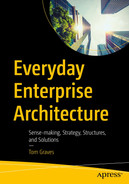Everyday Enterprise Architecture
Sense-making, Strategy, Structures, and Solutions

The Apress logo.
This Apress imprint is published by the registered company APress Media, LLC, part of Springer Nature.
The registered company address is: 1 New York Plaza, New York, NY 10004, U.S.A.
What exactly do we do every day in enterprise-architecture? What value does it deliver to the business? How do we develop our skills and experience, our judgment and awareness, so as to keep on enhancing the value that we deliver? And how do we do it fast, to respond to the real-time pressures of an always-on business world?
Many books on enterprise-architecture place an emphasis on frameworks, models, or methods – their overall theory of architecture, without much description of what actually happens in day-to-day practice. The reason for that gap is simple: if we start from theory, it’s hard to show much more than guidelines and principles without getting lost in irrelevant detail, because every architecture context is different.
So this book takes almost the opposite approach. We concentrate on the everyday activities that underpin each of the architecture disciplines – particularly the core processes such as sensemaking and design-thinking.
We explore how and why and when the various items of “theory-stuff” come into the picture – all those methods, frameworks, models, metamodels, and other information-sources.
And we show how to do all of that in a real architecture-project that must deliver real business-value in just two working weeks – not the two years or more required by some other approaches to enterprise-architecture. So yes, real enterprise-architecture, in real-time, that really does make business sense.
Use the architecture itself to explain how to do enterprise architecture.
Illustrate it by tackling a real enterprise-level business problem.
Exactly ten days in which to do it.
Starting now.
Go.
Interested? Read on…
Who Should Read This Book?
The principles and practice described here apply to every type of enterprise – for-profit, not-for-profit, government, whatever – and at every scale, from a global corporation all the way down to the local school’s sports-club. So in principle, and in practice too, it should be relevant to just about everyone.
This book should be especially useful for enterprise and business architects, but also for executives, strategists, strategic analysts, and any others who are tasked with understanding the enterprise as a whole.
Enterprise-architectures provide a “big-picture” overview for other architecture disciplines: so this would also be useful for process architects, security architects, solution architects, software architects, and the like.
What’s in This Book?
The aim of this book is to show what actually needs to happen in enterprise-architecture practice – not just its outcomes, but the activities from which those outcomes arise. As part of this, the book introduces a new technique called “context-space mapping,” which provides a structured method for sensemaking across the entire context of an enterprise. There’s also a strong emphasis here on what building-architects describe as “meta-thinking” – the reflective “thinking about thinking” through which the quality of personal practice is developed.
Diary-entries have their own distinct formatting to separate them from the main text |
We’ll use the project-diary for records, notes, sketch-diagrams, and anything else we’d need to document as we go along.
There are also various comments, anecdotes, asides, and examples – again drawn from real business practice – which are shown as follows:
A story, anecdote, or aside provides a real-world example of the point that’s being discussed in the main text.
Most books on enterprise-architecture and the like will include many illustrative models and diagrams, and this too follows that tradition. What’s different here is that many of these diagrams are adapted straight from the sketch-pad or whiteboard, to emphasize that this book is all about what happens in real-world practice.
How to use architecture ideas and activities to describe what actually happens in a real enterprise-architecture project, and the business-reasons and business-value for each of those activities
Using architecture to address a real enterprise-level business-problem that was a serious and urgent concern to one of our clients
The architecture activities for this second project are described in a separate section in the later part of each day’s chapter.
Each of those chapters ends with another section that provides suggestions for how to apply the same principles in your own architecture work.
There are also two additional chapters after the overall projects. The first of these describes the structures of the information-repositories needed for enterprise-architecture, and summarizes the respective content for each. The second of these two chapters provides more detail on context-space mapping, with some additional examples of cross-maps that can be useful in specific types of sensemaking. And finally there’s an appendix that lists the various resources referenced within the book.
That’s the overall structure of what follows. But the clock’s already ticking on this architecture-project: time to get started.
Among others, the following people kindly provided comments, advice, suggestions, and feedback on various ideas expressed in this book: Sally Bean (Sally Bean Consulting, GB), Shawn Callahan (Anecdote, Australia), Pat Ferdinandi (SBDI, USA), Paul Jansen (Jansen, BE), Anders Østergaard Jensen (Sydney, Australia), John Polgreen (GTRA, USA), Chris Potts (Dominic Barrow, GB), Kevin Smith (Pragmatic, GB), Michael Smith (Latidos, MX), Richard Veryard (NPRI, GB).
Please note that, to preserve commercial and personal confidentiality, the stories and examples in this book have been adapted, combined, and in part fictionalized from experiences in a variety of contexts, and do not and are not intended to represent any specific individual or organization.
Trademarks or registered trademarks such as Cynefin, Zachman, TOGAF, etc., are acknowledged as the intellectual property of the respective owners.

A photo of Tom Graves.

A photo of Daljit Banger.
Daljit has successfully managed several large professional teams of architects, written in several publications, and is the author of several freeware software products for enterprise architecture.
Daljit holds a Master of Science (MSc) degree and is a Chartered IT Fellow of the British Computer Society (BCS) and chairs the BCS Enterprise Architecture Specialist Group.
